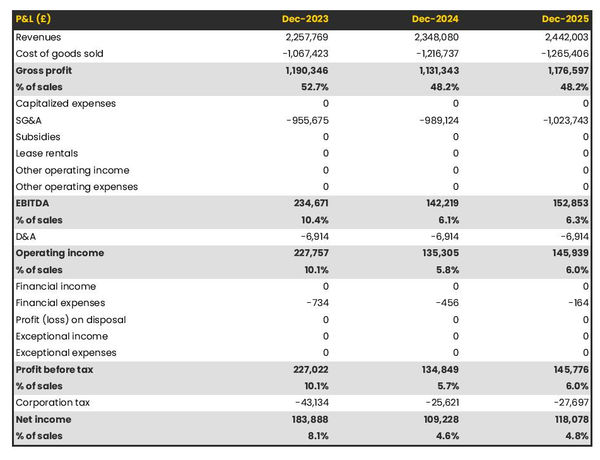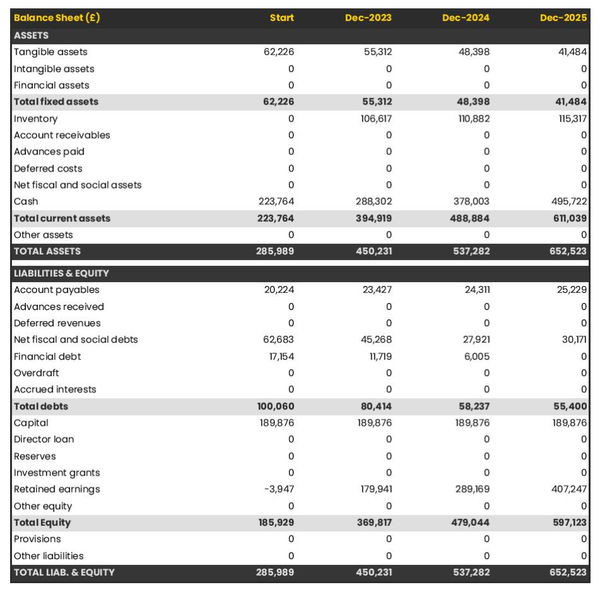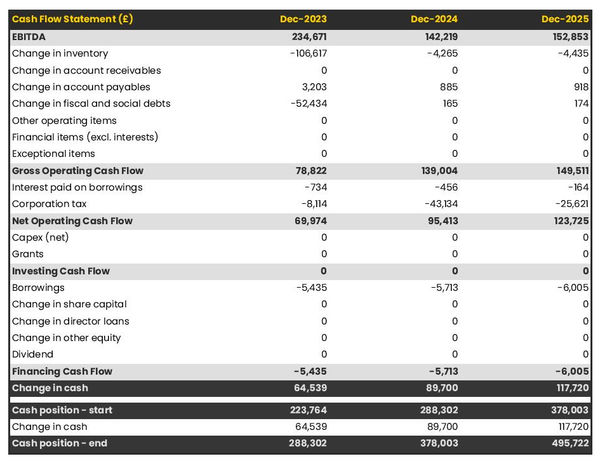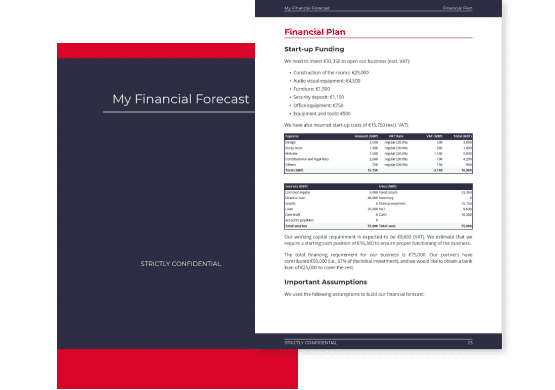How to create a financial forecast for a Spanish restaurant?

Developing and maintaining an up-to-date financial forecast for your Spanish restaurant is key in order to maintain visibility on your business’s future cash flows.
If you feel overwhelmed at the thought of putting together a Spanish restaurant financial forecast then don’t worry as this guide is here to help you.
We'll cover everything from: the main objectives of a financial forecast, the data you need to gather before starting, to the tables that compose it, and the tools that will help you create and maintain your forecast efficiently.
Let's get started!
Why create and maintain a financial forecast for a Spanish restaurant?
Creating and maintaining an up-to-date financial forecast is the only way to steer the development of your Spanish restaurant and ensure that it can be financially viable in the years to come.
A financial plan for a Spanish restaurant enables you to look at your business in detail - from income to operating costs and investments - to evaluate its expected profitability and future cash flows.
This gives you the visibility needed to plan future investments and expansion with confidence.
And, when your trading environment gets tougher, having an up to date Spanish restaurant forecast enables you to detect potential upcoming financing shortfalls in advance, enabling you to make adjustments or secure financing before you run out of cash.
It’s also important to remember that your Spanish restaurant's financial forecast will be essential when looking for financing. You can be 100% certain that banks and investors will ask to see your numbers, so make sure they’re set out accurately and attractively.
Need a solid financial forecast?
The Business Plan Shop does the maths for you. Simply enter your revenues, costs and investments. Click save and our online tool builds a three-way forecast for you instantly.

What information is used as input to build a Spanish restaurant financial forecast?
A Spanish restaurant's financial forecast needs to be built on the right foundation: your assumptions.
The data required to create your assumptions will depend on whether you are a new or existing Spanish restaurant.
If you are creating (or updating) the forecast of an existing Spanish restaurant, then your main inputs will be historical accounting data and operating metrics, and your team’s view on what to expect for the next three to five years.
If you are building financial projections for a new Spanish restaurant startup, you will need to rely on market research to form your go-to-market strategy and derive your sales forecast.
For a new venture, you will also need an itemised list of resources needed for the Spanish restaurant to operate, along with a list of equipment required to launch the venture (more on that below).
Now that you understand what is needed, let’s have a look at what elements will make up your Spanish restaurant's financial forecast.
The sales forecast for a Spanish restaurant
The sales forecast, also called topline projection, is normally where you will start when building your Spanish restaurant financial forecast.
Creating a coherent sales projection boils down to estimating two key drivers:
- The average price
- The number of monthly transactions
To do this, you will need to rely on historical data (for an existing business), market research data (for both new and existing Spanish restaurants), and consider the elements below:
- Seasonal fluctuations in demand: As a Spanish restaurant, your business may experience a higher number of monthly transactions during the summer months when tourists flock to your area. This could result in an increase in your average price as well, as tourists may be more willing to spend money on a unique dining experience.
- Menu changes and specials: Offering new dishes or seasonal specials can attract new customers and entice regulars to come back more frequently. This could lead to an increase in your average price and number of transactions, as customers may be willing to pay more for these limited-time items.
- Economic conditions: Changes in the economy, such as a recession or a rise in unemployment, can impact your business's average price and number of transactions. During tough economic times, customers may be more price-sensitive and opt for cheaper dining options, which could lower your average price and number of transactions.
- Competition: The presence of other Spanish restaurants in your area can affect your business's performance. If there are many similar restaurants nearby, it may be more challenging to stand out and attract customers. This could result in a decrease in your average price and number of transactions.
- Cultural events and holidays: Special events and holidays, such as Spanish festivals or celebrations, can bring in a surge of customers who are looking for a traditional Spanish dining experience. This could lead to an increase in your average price and number of transactions during these periods.
After the sales forecast comes the operating expenses budget, which we will now look into in more detail.
Need inspiration for your business plan?
The Business Plan Shop has dozens of business plan templates that you can use to get a clear idea of what a complete business plan looks like.

The operating expenses for a Spanish restaurant
The next step is to estimate the expenses needed to run your Spanish restaurant on a day-to-day basis.
These will vary based on the level of sales expected, and the location and size of your business.
But your Spanish restaurant's operating expenses should include the following items at a minimum:
- Staff costs: This includes wages, salaries, and benefits for your kitchen staff, wait staff, and management team.
- Food and beverage costs: This covers the cost of ingredients, beverages, and other supplies needed to prepare your Spanish dishes and drinks.
- Rent: This expense includes the cost of leasing your restaurant space.
- Utilities: This includes electricity, water, and gas bills for your restaurant.
- Equipment and maintenance: This covers the cost of purchasing and maintaining kitchen equipment, dining room furniture, and other necessary items.
- Marketing and advertising: This includes any expenses related to promoting your Spanish restaurant, such as print ads, online ads, and social media marketing.
- Accountancy fees: You may need to hire an accountant to manage your financial records and taxes.
- Insurance costs: This includes insurance for your restaurant, employees, and any liability coverage.
- Software licenses: If you use any software for reservations, inventory management, or other functions, you will need to pay for licenses or subscriptions.
- Banking fees: This includes fees for credit card processing, ATM fees, and other banking services.
- Cleaning and maintenance: This covers the cost of cleaning supplies, janitorial services, and general maintenance for your restaurant.
- Music and entertainment: If you have live music or other entertainment at your Spanish restaurant, this expense covers the cost of musicians or performers.
- Taxes and licenses: You will need to pay taxes on your restaurant's income, as well as any necessary business licenses.
- Training and development: This includes any costs associated with training your staff, such as workshops, seminars, or online courses.
- Packaging and to-go supplies: If you offer takeout or delivery, this expense covers the cost of packaging materials and to-go containers.
This list is, of course, not exhaustive, and you'll have to adapt it according to your precise business model and size. A small Spanish restaurant might not have the same level of expenditure as a larger one, for example.
What investments are needed to start or grow a Spanish restaurant?
Your Spanish restaurant financial forecast will also need to include the capital expenditures (aka investments in plain English) and initial working capital items required for the creation or development of your business.
For a Spanish restaurant, these could include:
- Kitchen Equipment: As a Spanish restaurant, you will need specialized equipment for cooking traditional dishes like paella and tapas. This may include a large paella pan, a plancha for grilling meats and seafood, and a deep fryer for making churros.
- Furniture and Decor: Creating an authentic Spanish atmosphere is crucial for a successful restaurant. This may involve investing in furniture such as wooden tables and chairs, as well as traditional decor items like colorful ceramic tiles and rustic artwork.
- Bar Equipment: Spanish cuisine is often accompanied by a variety of drinks, including sangria, wines, and cocktails. Therefore, your restaurant may need to purchase a bar setup with glassware, shakers, and other necessary tools.
- Point of Sale System: In order to efficiently manage orders and payments, a modern point of sale system is essential for any restaurant. This will allow you to track sales, inventory, and manage customer orders.
- HVAC System: Maintaining a comfortable temperature for your customers is important, especially during hot summers or chilly winters. Investing in a reliable heating, ventilation, and air conditioning (HVAC) system will ensure a pleasant dining experience for your guests.
Again, this list will need to be adjusted according to the size and ambitions of your Spanish restaurant.
Need a convincing business plan?
The Business Plan Shop makes it easy to create a financial forecast to assess the potential profitability of your projects, and write a business plan that’ll wow investors.

The financing plan of your Spanish restaurant
The next step in the creation of your financial forecast for your Spanish restaurant is to think about how you might finance your business.
You will have to assess how much capital will come from shareholders (equity) and how much can be secured through banks.
Bank loans will have to be modelled so that you can separate the interest expenses from the repayments of principal, and include all this data in your forecast.
Issuing share capital and obtaining a bank loan are two of the most common ways that entrepreneurs finance their businesses.
What tables compose the financial plan for a Spanish restaurant?
Now let's have a look at the main output tables of your Spanish restaurant's financial forecast.
The profit & loss forecast
The forecasted profit & loss statement will enable you to visualise your Spanish restaurant's expected growth and profitability over the next three to five years.

A financially viable P&L statement for a Spanish restaurant should normally show:
- Sales growing above inflation
- Stable or expanding (ideally) profit margins
- A net profit
This will of course depend on the stage of your business: a new venture might be loss-making until it reaches its breakeven point in year 2 or 3, for example.
The projected balance sheet
Your Spanish restaurant's projected balance sheet provides a snapshot of your business’s financial position at year-end.
It is composed of three types of elements: assets, liabilities and equity:
- Assets: represent what the business possesses including cash, equipment, and accounts receivable (money owed by clients).
- Liabilities: represent funds advanced to the business by lenders and other creditors. They include accounts payable (money owed to suppliers), taxes payable and loans from banks and financial institutions.
- Equity: is the combination of what has been invested by the business owners and the cumulative profits and losses generated by the business to date (which are called retained earnings). Equity is a proxy for the value of the owner's stake in the business.

The cash flow projection
The cash flow forecast of your Spanish restaurant will show how much cash the business is expected to generate or consume over the next three to five years.

There are multiple ways of presenting a cash flow forecast but from experience, it is better to organise it by nature in order to clearly show these elements:
- Operating cash flow: how much cash is generated by the Spanish restaurant's operations
- Investing cash flow: what is the business investing to expand or maintain its equipment
- Financing cash flow: is the business raising additional funds or repaying financiers (debt repayment, dividends)
Your cash flow forecast is the most important element of your overall financial projection and that’s where you should focus your attention to ensure that your Spanish restaurant is adequately funded.
Note: if you are preparing a financial forecast in order to try to secure funding, you will need to include both a yearly and monthly cash flow forecast in your Spanish restaurant's financial plan.
Need a solid financial forecast?
The Business Plan Shop does the maths for you. Simply enter your revenues, costs and investments. Click save and our online tool builds a three-way forecast for you instantly.

Which tool should you use to create your Spanish restaurant's financial projections?
Building a Spanish restaurant financial forecast is not difficult provided that you use the right tool for the job. Let’s see what options are available below.
Using online financial forecasting software to build your Spanish restaurant's projections
The modern and easiest way is to use an online financial forecasting tool such as the one we offer at The Business Plan Shop.
There are several advantages to using specialised software:
- You can easily create your financial forecast by letting the software take care of the financial calculations for you without errors
- You have access to complete financial forecast templates
- You get a complete financial forecast ready to be sent to your bank or investors
- You can easily track your actual financial performance against your financial forecast, and recalibrate your forecast as the year goes by
- You can create scenarios to stress test your forecast's main assumptions
- You can easily update your forecast as time goes by to maintain visibility on future cash flows
- You have a friendly support team on standby to assist you when you are stuck
- It’s cost-efficient and much cheaper than using an accountant or consultant (see below)
If you are interested in this type of solution, you can try our projection software for free by signing up here.
Calling in a financial consultant or chartered accountant
Enlisting the help of a consultant or accountant is also a good way to obtain a professional Spanish restaurant financial forecast.
The downside of this solution is its cost. From experience, obtaining a simple financial forecast over three years (including a balance sheet, income statement, and cash flow statement) is likely to cost a minimum of £700 or $1,000.
The indicative cost above, is for a small business, and a forecast is done as a one-shot exercise. Using a consultant or accountant to track your actuals vs. forecast and to keep your financial projections up to date on a monthly or quarterly basis will cost a lot more.
If you opt for this solution, make sure your accountant has in-depth knowledge of your industry, so that they may challenge your figures and offer insights (as opposed to just taking your assumptions at face value to create the forecast).
Why not use a spreadsheet such as Excel or Google Sheets to build your Spanish restaurant's financial forecast?
You and your financial partners need numbers you can trust. Unless you have studied finance or accounting, creating a trustworthy and error-free Spanish restaurant financial forecast on a spreadsheet is likely to prove challenging.
Financial modelling is very technical by nature and requires a solid grasp of accounting principles to be done without errors. This means that using spreadsheet software like Excel or Google Sheets to create accurate financial forecasts is out of reach for most business owners.
Creating forecasts in Excel is also inefficient nowadays:
- Software has advanced to the point where forecasting can be done much faster and more accurately than manually on a spreadsheet.
- With artificial intelligence, the software is capable of detecting mistakes and helping decision-making.
Spreadsheets are versatile tools but they are not tailor-made for reporting. Importing your Spanish restaurant's accounting data in Excel to track actual vs. forecast is incredibly manual and tedious (and so is keeping forecasts up to date). It is much faster to use dedicated financial planning tools like The Business Plan Shop which are built specially for this.
Need a convincing business plan?
The Business Plan Shop makes it easy to create a financial forecast to assess the potential profitability of your projects, and write a business plan that’ll wow investors.

Use our financial forecast templates for inspiration
The Business Plan Shop has dozens of financial forecast examples available.
Our templates contain both a financial forecast and a written business plan which presents, in detail, the company, the team, the strategy, and the medium-term objectives.
Our templates are a great source of inspiration, whether you just want to see what a complete business plan looks like, or are looking for concrete examples of how you should model financial elements in your own forecast.

Takeaways
- Having a financial forecast enables you to visualise the expected growth, profitability, and cash generation for your business over the next three to five years.
- Tracking actuals vs. forecast and keeping your financial projections up-to-date is the only way to get a view on what your Spanish restaurant future cash flows may look like.
- Using financial forecasting software is the mordern and easy way to create and maintain your forecasts.
This is the end of our guide on how to build the financial forecast for a Spanish restaurant, we hope you found it useful. Don't hesitate to contact us if you want to share your feedback or have any questions.
Need inspiration for your business plan?
The Business Plan Shop has dozens of business plan templates that you can use to get a clear idea of what a complete business plan looks like.

Also on The Business Plan Shop
Know someone who owns or is thinking of starting a Spanish restaurant? Share our forecasting guide with them!




